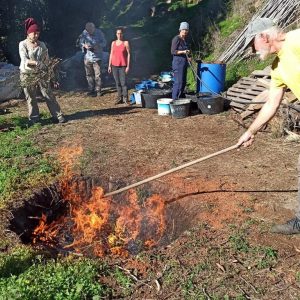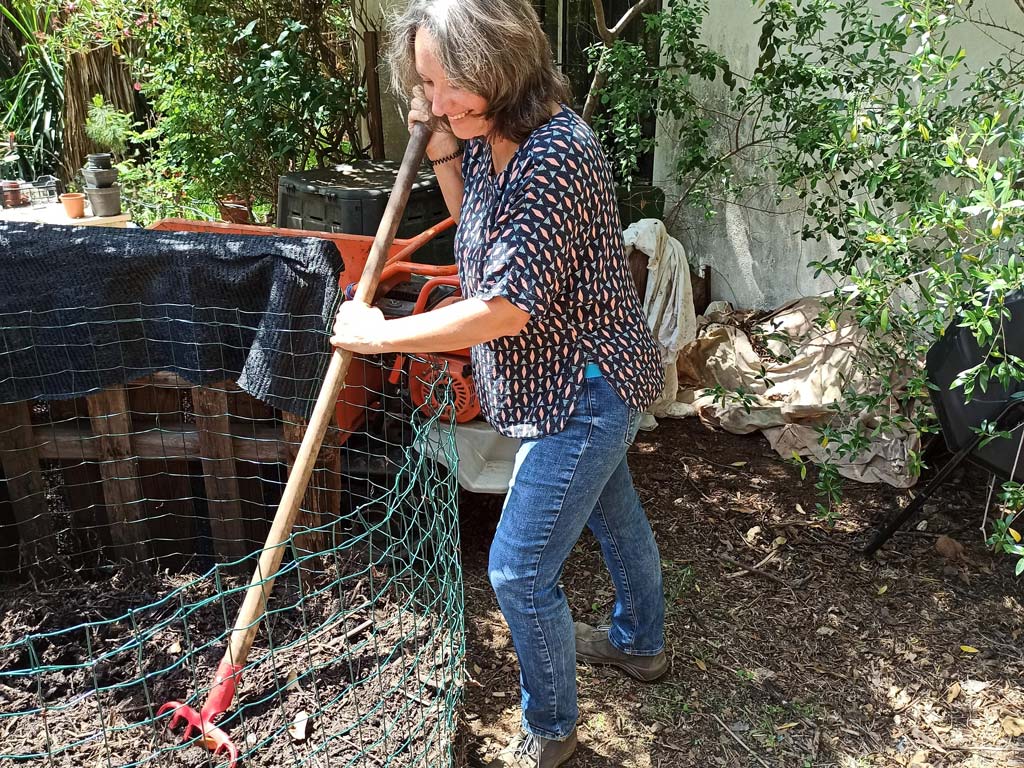In April, we set up a new compost pile.
We would like to produce compost rich in species with many microorganisms to enrich and strengthen the soil life in our garden. To do this, we use a recipe by Viviane Theby, which we learned about in her webinar.
For this compost we needed, among other things, high quality manure. Our neighbor Paqui’s family owns horses and lives on the hill across from us. They were happy to give us manure fresh from their young horses. All of the other components could be found on the finca.
First, ‚brown‘ portions such as wood chips, dried grass and weeds, and dry leaves were soaked in water. Then lawns were mowed and hedges trimmed so that we had the necessary amount of fresh ‚green‘ material ready. To this we added collected kitchen scraps and ground eggshells. Then came the fresh horse manure and the manure from our chickens. Another important ingredient was the charcoal we made in March. It stores nutrients from the compost and later gradually releases them to the soil. Viviane Theby’s compost recipe especially promotes the growth of fungi thanks to its high wood content – which are then a great and important enrichment for the soil!
Everything was proportionally layered in a wire mesh rack. We took care to ensure that everything was moist enough. The rack has a diameter of around one meter, is almost one meter high and thus has a capacity of 1000 liters.
From the beginning, we checked the temperature regularly. It quickly rose to over 55°C; 80°C must not be exceeded, otherwise there is a risk of spontaneous combustion. The high temperatures explain the name of this composting process: hot composting. The heat is generated by the bacteria contained: they multiply rapidly and decompose the organic material; heat is generated in the process. The high heat causes liquid to evaporate, but maintaining the right amount of water is important so that the organisms can move around, swimming in the liquid, and also drink. Therefore, the compost is turned after only a few days: after 24 to 72 hours depending on the core temperature. Water can be added during this process.
However, the turning has several more effects. For one thing, the materials are mixed together. The microorganisms can thus distribute themselves everywhere. In addition, everything is newly enriched with oxygen, which is essential for the aerobic bacteria to survive. At this point, they were already multiplying diligently.
Another goal of turning is that every part of the compost is in the core of the pile for a while. This is where the temperature is highest and ensures that weed seeds or any pathogens are heated once and thus rendered harmless. For this purpose, it is turned according to a specific schedule.
The temperature drops naturally during the turning, before it rises again. In our pile, it partly rose again after only a few hours. A good sign! Especially in the still cool morning air, our compost was steaming away. A beautiful picture! There was even a moment when the temperature got almost too high – 75°C!
So we used a broomstick to drill vertical tubes into the pile, which acted as chimneys and through which the hot steam could escape more quickly. This regulated the temperature as desired.
After all parts of the compost spent time in the core several times and everything developed well, we could stop turning it.
The rotting proceeded quickly, that is, the compost pile lost a lot of volume.
After about three weeks, the temperature dropped continuously, as it should, which is a consequence of the processes occurring in the pile.
The compost developed and matured over six to seven weeks as planned and looked very good. It had strongly collapsed, had a nice dark color and smelled delicious, like forest soil. There were even little mushrooms growing on it! We waited a little longer until the compost temperature had adjusted to the outside temperature.
Under the microscope, we were able to see fungal hyphae, shell amoebae, and other protozoa in a sample of the finished compost – all desirable and very gratifying!
The compost was then distributed in the vegetable beds.



